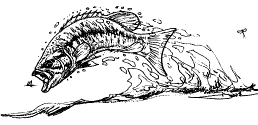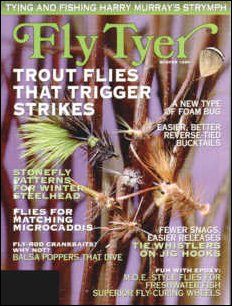
Check it Out

Headwaters:
a fish and angling art show
Here is a great selection of Hunting & Fishing magazines.
With 1200 Magazines to choose from you just can't go wrong
Help support this site by supporting our affiliates
All intellectual property and Pictures Copyright© of Robert Morger 1999. No reproductions of any material on this site is permitted without the express permission of the owner. All rights reserved.
The Onelist logo is a copyright of Onelist,Inc Copyright © 1998-1999, ONElist, Inc. All Rights
Reserved.
If you have suggestions or questions please contact rmorger@juno.com
Powered by counter.bloke.com
Dubbing for the Dubbing Impaired
Dubbing for the Dubbing Impaired Or How to apply hair to a fly without pulling all your 's out.
Ok I have to admit it I am dubbing impaired, in other words I have little to no experience with dubbing flies. I have read the books and magazines that say it is easy, I follow their instructions to a tee and still end up with some ugly aberration that wouldn't fool a blind starving fish. So I started looking into ways to solve my dilemma I went to my local flyshop but they weren't much help. They tried to show me how to do some simple dubbing, so I showed them how to really screw it up. They agreed that this was something I should stop doing immediately when they saw my monstrosity hanging in the vise. So the shop owner took me by the hand and guided me to a shelf and proceeded to tell me about a product that was just what I needed. Dubbing Brushes! Now these were beautiful little sticks of very fuzzy dubbing about 90mm long and five to a pack, they had about six or seven colors to choose from and they only cost a measly $4.95 each. Now you can get quite a few trout style flies from one of these packs, but only a few warm water flies and the colors are awful limited for what I tie but what the hell its only money. Well I took the plunge and bought a couple packs to try them out and low and behold they were good! They were easy to use just tie in one end and wrap in the area you wanted dubbing. They made a very nice looking fly, I was impressed, but still there was this cost thing to deal with. So I took one of these wonders and dissected it, gee a piece of fine wire and some store bought dubbing, real tough to duplicate. So here is what you do.
Materials you will need: Block of wood about 6" long. Scrap wood is fine just sand one side smooth. Sanding Paper about 200 grit and a triangle file. A couple small finishing nails or small eye screws. Handsaw router or other tool to make a groove in the wood block about 1/8" wide by no deeper than 1/8". Shallower is better in this case just so long as it is deeper than the diameter of your wire. Some fine brass copper or other wire. Ribbing wire works well so does the wire out of an old lamp cord. Dubbing material straight off a skin, store bought or any combination you feel like will work experiment it will pay off in the long run. Pair of wire nippers to cut your wire. A hobby drill is handy but not absolutely necessary.
How to make your form: 1. Take your block of wood and cut a groove in the middle, down the long wide side of the board. Do not cut more than about 1/8" deep, but make sure you cut from one end of the block to the other. 2. Run a triangle file through the cut you just made to smooth and taper the sides of the groove. Sand the side of the block where you cut the groove, make sure it is very smooth so it will not snag materials. 3. Take finishing nails (or eye screws) and tap them securely into the ends of the board directly below the groove. Leave them far enough down that they do not split the wood into the groove. Your form for making dubbing brushes is now complete and you are now ready to start assembling brushes. Note: You can make the form as long as you desire and you can add a good coating of paint or other sealant to the wood if you wish. Just make sure you end up with a smooth surface that is not sticky.
Assembling brushes: Now begins the fun part making the actual brushes. Start by cutting a piece of wire about two and a half times as long as the form, lay the wire into the groove so that about 1-1/2" sticks out from one end, make a wrap around the finishing nail to secure in place. Let the long end of the wire sit for the moment and attach the short end on the other side of the block to the eye of the eyebolt. Now you will need to place dubbing material across the smooth side of the block centered over the groove. How much you use is up to you and your taste in flies. I usually use quite a bit on brushes for saltwater and warm water species and keep it sparse for cold water species. Once you have your dubbing all laid out on the block, don’t sneeze or cough B^). Take the loose end of the wire and fold it back across the block trapping the material between the wires. Keeping the material between the wires attach the loose end of the wire to the eyebolt, pull on the eye bolt until the wire is under tension and all materials are trapped between tightly. Spin clockwise or counter clockwise until the material is secured tightly between the wires and can not be pulled out without some effort. This is where a small drill comes in handy, drop the eyebolt in the chuck and tighten it down, pull wire tight and switch the drill on, let it spin till the wire breaks at the eyebolt or the finishing nail. Advantages of making dubbing brushes: There are almost infinite color and texture combinations available by making your own brushes. It is much cheaper than buying them. You get a little glint of the underlying wire that shows through eliminating the need for ribbing in most cases. They are very easy to use, just tie them in and wrap in the areas needed. They open up the possibilities for new and interesting flies never before tied by others. If made correctly they can be used to substitute for materials not available. Did I mention they are much cheaper than buying them. Better use of materials, the next time you cut off the butts of that deer hair or flash material you will find yourself putting it aside to use in a brush instead of trashing it. They are easier to learn how to make then messing with loops and such. Last but not least they are much cheaper than buying brushes. Disadvantages of dubbing brushes: They add weight to a fly that you may not want or need, this mainly effects smaller dry flies more than any other type of fly. They are a separate step that has to be done before you can tie your flies. They can be aggravating until you get the building process down pat. They can become addictive to the tier who gets involved with them. Some tips and ideas for you to chew on: Use the drill to twist your wire it saves a bunch of time and aggravation. Don’t attempt to do this when you have a fan running behind you or you have a head cold. One good puff of air and I guarantee you will be ticked off. If you want to add a good deal of weight to a fly and dub it at the same time use lead wire of the size needed and trap dubbing between. This is the one time I do not recommend using the drill to twist your wire. Use deer hair or other type of hair and stack so the tips are even lay across the trough so that all but a small portion of the hair is on one side of the cut. Pull wire tight and trim the butts very short so almost all hair is on one side of wire then spin. Use this in place of a feather as a hackle for some heavily hackled flies. Alternate colors of dubbing to get a variegated effect, or add flash material to brighten up your material to add sparkle. Use marabou fibers to make a very lively dubbing that cant be beat for dragonfly nymphs and the underbody on yabbies and shrimp. Find wires that are different colors and diameters copper wire can be found in all different colors if you don’t mind unwinding small electric motors. Very sparsely dubbed brushes will make nicely segmented bodies on nymphs vary the size of the wire to change the effect. You are in control of the final product if you don’t like what you made start over and get it right. As you can see I am still dubbing impaired but now it is a good thing. Although I still cant dub my way out of a paper bag with a thread loop even if my life depended on it. I can dub a mean fly using the dubbing brush technique, and you can to. Its easy so give it a try, you may find yourself spending a lot of time making new and interesting brushes to use on the flies we love to tie. I hope this helps all of you in your quest for the perfect fly. Tight Lines, Screaming Reels and Bright Fish to All, Robert Morger |

